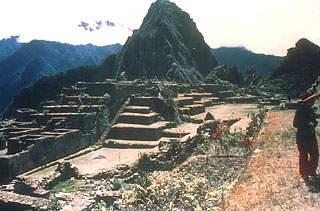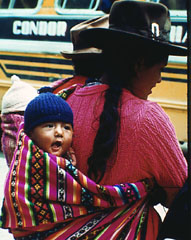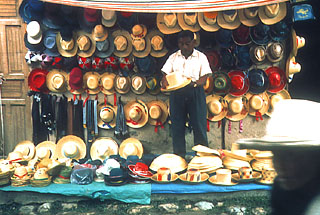 Perú is almost the same size as the state of Alaska in the United States. The
country is divided into three distinct geographic regions: the dry coastal plain on
the west coast, the high Andes Mountains in the center, and the tropical lowlands of
the Amazon Basin in the east. Temperatures vary greatly from the coast to the
highlands to the jungle. The capital city of Lima has an average annual temperature
of about 65° F.
Perú is almost the same size as the state of Alaska in the United States. The
country is divided into three distinct geographic regions: the dry coastal plain on
the west coast, the high Andes Mountains in the center, and the tropical lowlands of
the Amazon Basin in the east. Temperatures vary greatly from the coast to the
highlands to the jungle. The capital city of Lima has an average annual temperature
of about 65° F.
Several advanced cultures have lived in Perú. The last of these groups were
the Incas. They are particularly noted for the art of stonecutting. Many of the
ruins of their ancient cities are impressive. The ruins of Machu Picchu are
especially impressive.
Government and Economy
There are 24 departamentos (states) in Perú. There is a president, a
Senate, and a Chamber of Deputies.
The Peruvian economy struggled in the early part of this decade. Reforms have caused the economy to strengthen, being especially boosted by foreign investment. Approximately one-half of the Peruvians live in poverty.
Perú's natural resources include oil, copper, gold, and silver. The fish harvest in Perú is one of the largest in the world. Important agricultural products include wheat, sugarcane, potatoes, rice, and coffee.
The currency is the nuevo sol.
Language and People
 There are approximately 24.5 million people in Perú, the capital of Lima
accounts for over 7 million. The largest group of people are the Indians, many are
descendants of the Incan Empire. The other ethnic groups include a large population
of mestizos, a considerable population of European descendants, and a minority
of Blacks, Japanese, Chinese, and other groups.
There are approximately 24.5 million people in Perú, the capital of Lima
accounts for over 7 million. The largest group of people are the Indians, many are
descendants of the Incan Empire. The other ethnic groups include a large population
of mestizos, a considerable population of European descendants, and a minority
of Blacks, Japanese, Chinese, and other groups.
The languages are as diverse as the people. Spanish and the Indian language of
Quechua are the official languages of Perú.
A second Indian language of
Aymará is also widely spoken. Many Peruvians speak both Spanish and an Indian
language.
Greetings
The general greetings of ¡Buenos días!, ¡Buenas tardes!
and ¡Buenas noches! are commonly used. Remember that if you are meeting
someone for the first time to use the formal usted form of the Spanish verbs to
show respect.
Friends address each other by their first names. Others use the titles of Señor (Mr.), Señora (Mrs.), and Señorita (Miss) are also used.
Food
The main staple foods in Perú include rice, beans, fish, potatoes, and a
variety of tropical fruits. A favorite dish is papa a la huancaina (baked
potato with sliced eggs and sauce). Seviche (raw fish seasoned with lemon and
vinegar) is popular along the coast whereas potatoes, onions, and garlic are popular
in the highlands.
Here is a recipe for:
Huancaina
Ingredients:
1/2 pound feta cheese, very finely crumbled 1/2 pound Parmesan cheese, grated 2 tablespoons chopped fresh green chili peppers 4 egg yolks 3 tablespoons fresh lemon juice 11/4 pounds whole kernel corn 3/4 cup olive oil 1 tablespoon olive oil 1 cup minced onions 1/8 tablespoon tumeric 1 cup heavy cream Salt and pepper, to taste In a medium-sized bowl, combine the cheeses, chili peppers, egg yolks, and lemon juice.
Grind corn in a blender or food processor. Blend ground corn into cheese mixture. Very slowly drizzle in the 3/4 cup olive oil, stirring constantly to keep the sauce combined.
Pour 1 tablespoon olive oil into a large skillet and sauté onions until translucent. Stir in tumeric, corn mixture and cream. Season with salt and pepper to taste.
Huancaina is a sauce that can be put on any type of meat, poultry, or vegetables.
 Soccer is the most popular sport in Perú. Basketball and volleyball are also
popular.
Soccer is the most popular sport in Perú. Basketball and volleyball are also
popular.
Peruvian music is especially popular. Some of the instruments used in this type of music include the charango, a small guitar with twelve strings, and the siku, a flute similar to the panpipe.
Important holidays include Independence Day (July 28), National Day (July 29), and St.
Rose of Lima Day (August 30). Many local holidays also honor patron saints and
harvests.
For more information about Perú, please visit:
Photos courtesy of the UN.